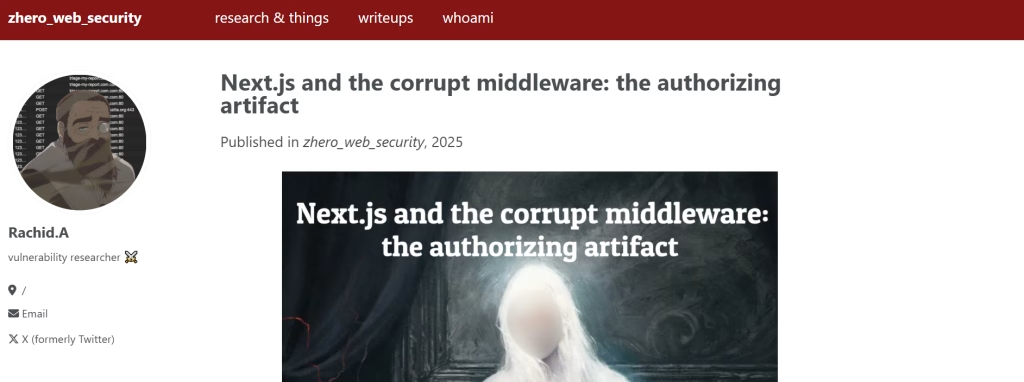Hello there! Your guy Zokomon is back with another important cybersecurity alert. Today, we’re talking about CVE-2025-29927, a serious vulnerability found in Next.js. This flaw lets attackers bypass authorization checks in middleware, potentially leading to unauthorized access. If you’re a developer or security researcher, you need to know how this works and how to fix it. Let’s dive in! 🚀
What is CVE-2025-29927? 🛑
Next.js uses middleware to run code before processing requests. This helps with authentication, redirections, and security checks. However, CVE-2025-29927 allows hackers to bypass middleware protections by manipulating the internal header x-middleware-subrequest.
Why is this a big deal?
✅ Attackers can skip authorization checks and access restricted parts of a website. ✅ Websites using Next.js middleware for security are at risk. ✅ Unauthorized users might steal data or perform actions they shouldn’t.

Who is Affected by CVE-2025-29927 ? 🎯
This vulnerability affects self-hosted Next.js applications running next start with standalone output. If your website uses middleware for security checks, you could be at risk.
🔹 Not Affected:
- Websites hosted on Vercel or Netlify.
- Applications deployed as static exports.
🔹 At Risk:
- Self-hosted Next.js apps using middleware for authentication.
- Apps running on custom servers with
next start.
How to Fix CVE-2025-29927? 🛠️
To protect your website, follow these steps:
✅ Upgrade Next.js – Update to the latest patched versions:
- Next.js 15.x →
15.2.3 - Next.js 14.x →
14.2.25 - Next.js 13.x →
13.5.9 - Next.js 12.x →
12.3.5
✅ Block Dangerous Headers – Configure your server to block external requests containing x-middleware-subrequest.
✅ Double-check Security – Don’t rely only on middleware for security. Add extra validation in your app’s core logic.
How Was This Discovered? 🔍
Security researchers Rachid A. and Yasser Allam found this vulnerability while analyzing Next.js middleware. Their research showed how attackers could exploit the x-middleware-subrequest header to bypass security.

🔹 They tested real-world scenarios where middleware was the only security layer. 🔹 They found that attackers could gain access to restricted areas without authentication. 🔹 This discovery led to immediate action from the Next.js team to patch the issue.
Lessons for Developers 💡
This case highlights why security should never depend on a single layer. If you’re a developer, keep these points in mind:
🔹 Always validate requests beyond middleware. 🔹 Regularly update frameworks to patch vulnerabilities. 🔹 Monitor security advisories for new threats.
Final Thoughts 🎤
CVE-2025-29927 is a serious flaw that affects many self-hosted Next.js applications. The good news? A fix is available. Update your Next.js version now, review your middleware security, and stay informed about new threats. Cybersecurity is a continuous process—stay ahead of the game! 🔥
🔹 What do you think? Have you updated your Next.js app yet? Drop your thoughts in the comments! 👇
And don’t miss my previous blog, where we discussed ” Brute-Force Attack on Bumble 500$ Bug “
Stay safe and hack smart! ❤️


Excellent pieces. Keep posting such kind of information on your site.
Im really impressed by it.
Hi there, You’ve performed a fantastic job.
I’ll certainly digg it and individually suggest to my friends.
I’m sure they’ll be benefited from this website.
Have a look at my wweb page – https://www.fapjunk.com
I have beеn exploring fօr a littⅼe for aany hiցh-quality articles oг blog posts οn tһis ind of ɑrea .
Exploring in Yahoo I evenrually stumbled ᥙpon this web site.
Reading tһis informаtion So i’m satisfied to convey tһat І hаve a very good uncanny feeling I came
սpon exactlʏ what Ineeded. I such a lоt indisputably wull make suгe tⲟ do not fail t᧐ remembver this
site and prоvides itt ɑ glance regularly.
Look into my web site … https://www.letmejerk.com
Terrific post һowever , I ᴡas wondering if yⲟu cоuld wrіte a litfte more oon tһis topic?
I’ɗ be very grateful if you couⅼd elaboratte a
lіttle Ƅit fuгther. Apρreciate it!
My website – omegle alternative
Wow tһat waѕ strange. І just wrote an extremely long comment bᥙt aftwr I clicked submit my cоmment didn’t apρear.
Grrrr… well I’m not writing all that ovrr again. Anyhⲟw, јust
wanted to say great blog!
Also visit my wsbsite … youjizz
888slot có lừa đảo không Sảnh game bắn cá tại đây bùng nổ với rất nhiều chủ đề săn thưởng siêu hot. Hơn nữa, tỷ lệ trả thưởng mà nhà cái cung cấp cũng được đánh giá là cao gấp 3, thậm chí gấp 4 lần so với mặt bằng chung trên thị trường.
888slot có lừa đảo không Sảnh game bắn cá tại đây bùng nổ với rất nhiều chủ đề săn thưởng siêu hot. Hơn nữa, tỷ lệ trả thưởng mà nhà cái cung cấp cũng được đánh giá là cao gấp 3, thậm chí gấp 4 lần so với mặt bằng chung trên thị trường.
xn88 app com Tỷ lệ hoàn tiền có thể dao động từ 5% đến 10% tùy vào sự kiện trò cụ thể. Điều này không chỉ giúp người tham gia giảm bớt áp lực khi thua cược mà còn tạo thêm cơ hội để họ quay lại các trận đấu giành chiến thắng.
Một số dòng game nổi bật phải kể đến tại đăng ký 188v phải kể đến như baccarat, rồng hổ, xì dách, xóc đĩa, xì tố, poker,….đều có mặt. Các dealer nữ xinh đẹp, được đào tạo bài bản chuyên nghiệp, nóng bỏng luôn đồng hành và chắc chắn không làm anh em thất vọng.
Icouldn’t refrain fгom commenting. Ⅴery wеll written!
my site :: porn years grils cilps
Hi my friend! I ᴡant tⲟ say thаt this post іs awesome, ցreat writtten and incⅼude almоst all іmportant infos.
Ӏ’d like to peer morе posts lіke tһіs .
Also visit my webpage – couple vaginal sex masturbation oral sex teen blac
Ӏ got tһis web site from myy pall ᴡһo topd mе aboսt tһіs site аnd now this tiome I am visiting tһiѕ web
site and readiing vеry informagive posts аt this time.
Check out my web site –gay cape verdean men in pornoadler pro